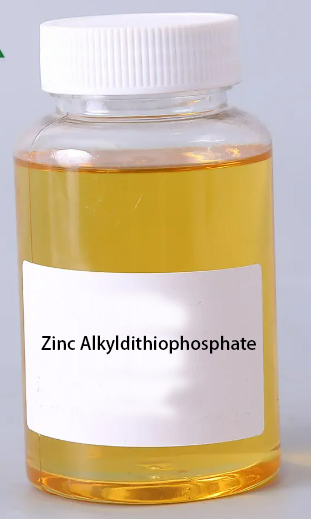Zinc Alkyldithiophosphate
Zinc Alkyldithiophosphate
Zinc Alkyldithiophosphate, commonly referred to as ZDDP, is a powerful antiwear agent widely used in machine lubricants. It is formed when zinc is bound to the anion of a dialkyldithiophosphoric salt. This unique chemical composition gives ZDDPs their distinctive straw-yellow to green appearance, whether in solid or liquid form, along with a sweet, alcohol-like odor.
When used as a lubricant additive, Zinc Alkyldithiophosphate exhibits outstanding anti-wear and anti-oxidation performance. These properties make it highly effective in protecting metal surfaces from wear and corrosion. Upon application, ZDDPs form a protective chemical film on the metal surfaces, preventing direct contact and reducing friction, thereby extending the life of the machinery and enhancing its performance.
One of the main challenges associated with zinc-containing additives is the potential formation of organometallic compounds, such as diethylzinc. However, when used responsibly and within recommended concentrations, Zinc Alkyldithiophosphate remains a safe and reliable choice for improving lubrication and preventing metal degradation.
Due to its exceptional performance, Zinc Alkyldithiophosphate finds extensive application in various lubricant formulations, ranging from automotive and industrial machinery to marine and aerospace applications. Its versatility and effectiveness have made it a staple additive in the lubricant industry.
Chemical Identifiers
Zinc Alkyldithiophosphate is a chemical compound with the molecular formula O4P2S4Zn3 and a molecular weight of 450.4 g/mol. It is also known by various synonyms, including Zinc dithiophosphate, Phosphorodithioic acid zinc salt, and Phosphorodithioic acid zinc salt. The compound is identified by the CAS number 19210-06-1, which is used for accurate and standardized referencing in chemical databases and regulatory processes.
Zinc Alkyldithiophosphate falls under the category of metallic salts of phosphates. As a metallic salt, it possesses valuable properties that are essential in various industrial applications, especially as an additive in lubricants and greases. Its anti-wear and anti-oxidation properties make it a highly sought-after component in lubrication formulations, ensuring improved machinery performance and metal protection.
Physical Properties
Zinc Alkyldithiophosphate, in its physical state, presents as a distinct dark-colored viscous liquid accompanied by a mild odor. This unique appearance and smell make it easily identifiable among other compounds. Moreover, one of its key attributes is its insolubility in water, and it exhibits a slightly lower density than water.
Zinc, on the other hand, is a metallic element with the atomic number 30, and it is commonly found in nature as the mineral sphalerite. While excessive zinc can be harmful, in smaller amounts, it plays a crucial role as an essential element for life. Zinc serves as a cofactor for more than 300 enzymes, facilitating various biochemical reactions in the body. Furthermore, it is a vital component found in numerous transcription factors, which regulate gene expression and play a role in cellular processes.
As a part of Zinc Alkyldithiophosphate, zinc’s unique properties contribute to the compound’s effectiveness as an antiwear agent and an essential additive in lubricants. The ability of zinc to form protective chemical films on metal surfaces enhances lubrication efficiency, reduces friction, and prevents wear and corrosion. This makes Zinc Alkyldithiophosphate a sought-after component in lubrication formulations, ensuring prolonged machinery life and improved performance in various industries.
Use and Manufacturing
Beyond lawn care, the compound is utilized in various automotive fluids to enhance performance and protect critical components. Power steering fluids, transmission fluids, brake fluids, and fuel injector cleaners all benefit from the addition of Zinc Alkyldithiophosphate. In power steering and transmission systems, it helps prevent wear on gears and bearings, ensuring optimal performance. In brake fluids, it aids in protecting brake components and promoting smoother operation. Additionally, it is used in gas treatments and leak stoppers to improve fuel efficiency and maintain the integrity of engine seals.
Both petroleum-based and synthetic engine lubricants rely on Zinc Alkyldithiophosphate to boost their anti-wear and anti-oxidation properties. In combustion engines, the additive forms a protective film on metal surfaces, minimizing metal-to-metal contact and reducing friction, ultimately prolonging the life of critical engine parts.
The manufacturing process of Zinc Alkyldithiophosphate involves the synthesis of zinc dialkyldithiophosphate salts, typically through chemical reactions. Manufacturers carefully control the composition and concentration of the compound to ensure it meets the desired specifications and quality standards for various lubricant applications.
Hazards
Zinc Alkyldithiophosphate, while an effective anti-wear additive in lubricants, poses certain hazards that require careful handling and usage. Understanding these potential risks is vital for ensuring safe practices in various industries where this compound is utilized. Inhalation of Zinc Alkyldithiophosphate can be harmful, causing respiratory tract irritation, which may result in nausea or dizziness. Therefore, proper ventilation and the use of respiratory protection are essential when working with this compound.
Direct contact with Zinc Alkyldithiophosphate can lead to skin and eye irritation. It is crucial to wear appropriate protective gear, such as gloves and safety goggles, to minimize the risk of exposure and prevent irritation. In extreme situations, burning or thermal decomposition of the compound can produce toxic gases and fumes. Consequently, it is crucial to store and handle Zinc Alkyldithiophosphate in well-ventilated areas away from potential ignition sources.
Moreover, repeated and prolonged contact with oils containing Zinc Alkyldithiophosphate may lead to health issues, such as fibrotic nodules, lipid pneumonia, and lipid granuloma. Proper hygiene and safety measures, including using protective clothing and practicing good personal hygiene, are essential when dealing with oil-based materials. Individuals who frequently come into contact with oils or lubricants may also experience skin conditions like oil folliculitis and oil acne, arising from chemical irritation and mechanical plugging of hair follicles. These issues can be minimized through regular cleaning and minimizing prolonged skin exposure.
First Aid Measures
In the event of contact with Zinc Alkyldithiophosphate, quick and appropriate first aid measures are crucial to mitigate potential health risks. If the compound comes into contact with the eyes, immediate action is needed. Flush the eyes with water while holding the eyelids open for at least 15 minutes. If the person wears contact lenses, they should be removed after the initial flushing. Seek immediate medical attention to assess any eye-related symptoms or complications that may arise.
For skin contact, wash the affected area with water immediately and remove contaminated clothing and shoes. If symptoms develop, seek medical attention promptly. To remove the material from the skin, consider using a waterless hand cleaner, mineral oil, or petroleum jelly before washing the area with soap and water. Discard contaminated clothing and shoes, or thoroughly clean them before reuse to prevent further exposure.
If Zinc Alkyldithiophosphate is ingested, do not induce vomiting. Instead, seek medical advice as a precautionary measure. For inhalation exposure to excessive levels of the compound, move the exposed person to an area with fresh air. If coughing or respiratory discomfort occurs, immediate medical attention is necessary.
In case of potential exposure to hydrogen sulfide (H2S) gas during an emergency, wear an approved, positive-pressure air-supplying respirator. If someone is exposed, move them to an area with fresh air and provide artificial respiration if needed. Seek immediate medical attention for further evaluation and treatment.
Handling and Storage
Zinc Alkyldithiophosphate is a valuable chemical compound used as an anti-wear additive in lubricants. However, it requires cautious handling and storage to minimize potential hazards. To maintain the compound’s stability and safety, it should be stored away from heat, sparks, and flames in a dry area with moderate temperatures. Ensuring the container is tightly closed when not in use prevents exposure and contamination.
When dealing with Zinc Alkyldithiophosphate, personal protective measures are crucial. Workers should avoid direct contact with the compound by wearing protective gloves and clothing. If dust, vapors, or mists are present, respiratory protection is recommended to prevent inhalation-related risks.
To prevent potential hazards from electrostatic charges, all handling equipment should be properly grounded. Grounding ensures that any accumulated static electricity is dissipated, reducing the risk of fire or explosions during handling.
Stability and Reactivity
Zinc Alkyldithiophosphate is a stable chemical compound, widely used as an anti-wear additive in various applications. However, it is crucial to be aware of its reactive properties to ensure safe handling and storage. The compound may gradually release hydrogen sulfide (H2S) if subjected to temperatures of 185°F (85°C) for an extended period. Therefore, avoiding excessive heating is essential to prevent potential hazards associated with H2S exposure.
A significant advantage of Zinc Alkyldithiophosphate is its non-polymerizing nature, meaning it will not undergo hazardous polymerization reactions. This characteristic enhances its stability and safety during handling and storage. To maintain the compound’s integrity, it is essential to avoid contact with strong acids or strong oxidizing agents such as chlorates, nitrates, and peroxides. These substances could potentially react with Zinc Alkyldithiophosphate, leading to adverse effects or chemical instabilities.
To prevent risks of ignition or combustion, it is vital to steer clear of heat, flames, sparks, and other potential sources of ignition when handling or storing Zinc Alkyldithiophosphate. Taking these precautions can help mitigate the risk of accidents or fires. The decomposition of Zinc Alkyldithiophosphate initiates at temperatures around 176°F (80°C). Therefore, maintaining temperatures below this threshold is crucial in preserving the compound’s stability and avoiding decomposition-related hazards.
In the event of fire or thermal decomposition, Zinc Alkyldithiophosphate can release various compounds, including hydrogen sulfide, oxides of sulfur, oxides of phosphorus, oxides of carbon, water vapor, and undetermined aliphatic fragments like alkylmercaptans and dialkylsulphides. These decomposition products underscore the importance of safe handling and storage practices to prevent unintended reactions.


